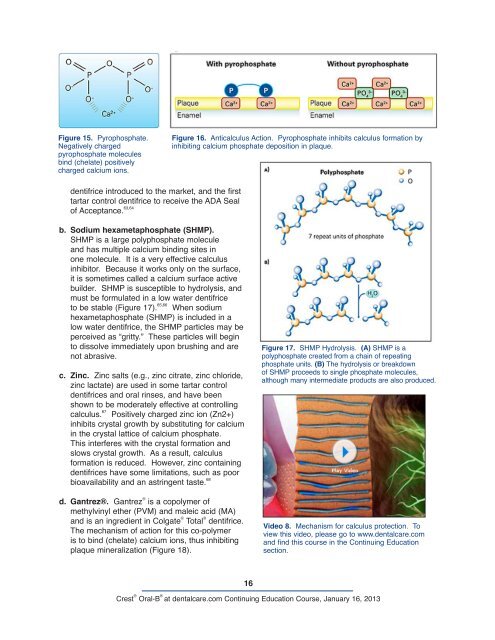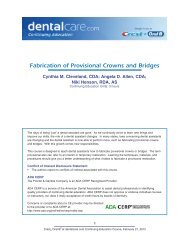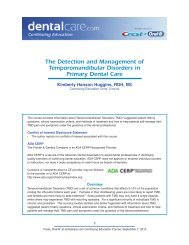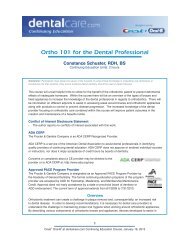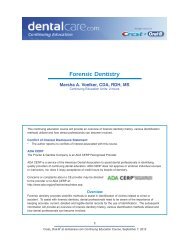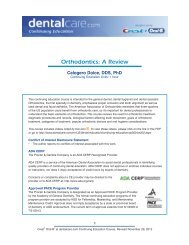CE410 - Fundamentals of Dentifrice: Oral Health ... - DentalCare.com
CE410 - Fundamentals of Dentifrice: Oral Health ... - DentalCare.com
CE410 - Fundamentals of Dentifrice: Oral Health ... - DentalCare.com
Create successful ePaper yourself
Turn your PDF publications into a flip-book with our unique Google optimized e-Paper software.
Figure 15. Pyrophosphate.<br />
Negatively charged<br />
pyrophosphate molecules<br />
bind (chelate) positively<br />
charged calcium ions.<br />
dentifrice introduced to the market, and the first<br />
tartar control dentifrice to receive the ADA Seal<br />
<strong>of</strong> Acceptance. 63,64<br />
b. Sodium hexametaphosphate (SHMP).<br />
SHMP is a large polyphosphate molecule<br />
and has multiple calcium binding sites in<br />
one molecule. It is a very effective calculus<br />
inhibitor. Because it works only on the surface,<br />
it is sometimes called a calcium surface active<br />
builder. SHMP is susceptible to hydrolysis, and<br />
must be formulated in a low water dentifrice<br />
to be stable (Figure 17). 65,66 When sodium<br />
hexametaphosphate (SHMP) is included in a<br />
low water dentifrice, the SHMP particles may be<br />
perceived as “gritty.” These particles will begin<br />
to dissolve immediately upon brushing and are<br />
not abrasive.<br />
c. Zinc. Zinc salts (e.g., zinc citrate, zinc chloride,<br />
zinc lactate) are used in some tartar control<br />
dentifrices and oral rinses, and have been<br />
shown to be moderately effective at controlling<br />
calculus. 67 Positively charged zinc ion (Zn2+)<br />
inhibits crystal growth by substituting for calcium<br />
in the crystal lattice <strong>of</strong> calcium phosphate.<br />
This interferes with the crystal formation and<br />
slows crystal growth. As a result, calculus<br />
formation is reduced. However, zinc containing<br />
dentifrices have some limitations, such as poor<br />
bioavailability and an astringent taste. 68<br />
d. Gantrez®. Gantrez ® is a copolymer <strong>of</strong><br />
methylvinyl ether (PVM) and maleic acid (MA)<br />
and is an ingredient in Colgate ® Total ® dentifrice.<br />
The mechanism <strong>of</strong> action for this co-polymer<br />
is to bind (chelate) calcium ions, thus inhibiting<br />
plaque mineralization (Figure 18).<br />
Figure 16. Anticalculus Action. Pyrophosphate inhibits calculus formation by<br />
inhibiting calcium phosphate deposition in plaque.<br />
16<br />
Figure 17. SHMP Hydrolysis. (A) SHMP is a<br />
polyphosphate created from a chain <strong>of</strong> repeating<br />
phosphate units. (B) The hydrolysis or breakdown<br />
<strong>of</strong> SHMP proceeds to single phosphate molecules,<br />
although many intermediate products are also produced.<br />
Video 8. Mechanism for calculus protection. To<br />
view this video, please go to www.dentalcare.<strong>com</strong><br />
and find this course in the Continuing Education<br />
section.<br />
Crest ® <strong>Oral</strong>-B ®<br />
at dentalcare.<strong>com</strong> Continuing Education Course, January 16, 2013


